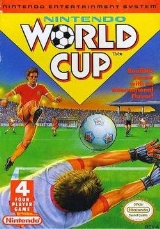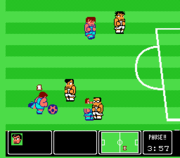
Nintendo World Cup
Encyclopedia
Nintendo World Cup is a soccer video game for the Nintendo Entertainment System
and Game Boy
, developed by Technōs Japan and released in 1990. The NES version is a localization of , the fourth Kunio-kun game released for the Family Computer. Ports for the PC-Engine
and Sega Mega Drive were also released in Japan only. The Game Boy version of the game was released in Japan as and was based on the American release of the NES version.
 At its core, the game follows the rules of soccer, but with noticeable differences. Each team has only six players (a goalkeeper, two defenders
At its core, the game follows the rules of soccer, but with noticeable differences. Each team has only six players (a goalkeeper, two defenders
, a midfielder
and two forwards). You control only one of them, but you can give commands (Pass/Shoot) to the others. Offsides are non-existent and fouls are not punished. Players can be knocked out by repeatedly sliding, tackling or shooting them, afterwards they will stay down for the rest of the half. Players can also use up to five "super shots" per half; these powerful, odd-looking shots are used whenever a player does a bicycle kick or a diving header, or when he shoots after walking a certain number of steps. The "super shots" differ from player to player. The playing fields also differ in respect to material, e.g. ice, which heavily impacts movement of both, players and the ball.
There are two game modes:
Graphically, the game looks similar to others in the Kunio-kun series, particularly River City Ransom
, with its short-legged, big-headed characters with varied faces; in fact, some sprite
s, such as Kunio and the other members of the Japanese team, were reused from River City Ransom.
Some of the teams had naming issues:
.
In addition for the PC Engine Super CD-ROM² version, includes five national teams (France, Brazil, Argentina, Italy and Germany) in Tournament mode which is after beating the final match.
Nintendo Entertainment System
The Nintendo Entertainment System is an 8-bit video game console that was released by Nintendo in North America during 1985, in Europe during 1986 and Australia in 1987...
and Game Boy
Game Boy
The , is an 8-bit handheld video game device developed and manufactured by Nintendo. It was released in Japan on , in North America in , and in Europe on...
, developed by Technōs Japan and released in 1990. The NES version is a localization of , the fourth Kunio-kun game released for the Family Computer. Ports for the PC-Engine
TurboGrafx-16
TurboGrafx-16, fully titled as TurboGrafx-16 Entertainment SuperSystem and known in Japan as the , is a video game console developed by Hudson Soft and NEC, released in Japan on October 30, 1987, and in North America on August 29, 1989....
and Sega Mega Drive were also released in Japan only. The Game Boy version of the game was released in Japan as and was based on the American release of the NES version.
Overview

Defender (association football)
Within the sport of association football, a defender is an outfield player whose primary role is to prevent the opposition from attacking....
, a midfielder
Midfielder
A midfielder is an association football position. Some midfielders play a more defensive role, while others blur the boundaries between midfielders and forwards. The number of midfielders a team uses during a match may vary, depending on the team's formation and each individual player's role...
and two forwards). You control only one of them, but you can give commands (Pass/Shoot) to the others. Offsides are non-existent and fouls are not punished. Players can be knocked out by repeatedly sliding, tackling or shooting them, afterwards they will stay down for the rest of the half. Players can also use up to five "super shots" per half; these powerful, odd-looking shots are used whenever a player does a bicycle kick or a diving header, or when he shoots after walking a certain number of steps. The "super shots" differ from player to player. The playing fields also differ in respect to material, e.g. ice, which heavily impacts movement of both, players and the ball.
There are two game modes:
- Tournament mode, in which one or two players take control of one of the 13 available teams, in order to defeat their CPU-controlled opponents.
- VS Match mode, which enables players to confront each other on sand, ice or dirt playing fields. Up to four players can compete using the NES Four ScoreNES Four ScoreThe NES Four Score is an accessory for the Nintendo Entertainment System created by Nintendo. It allows four-player gameplay on games that supported it. The Four Score was released in 1990....
or the NES SatelliteNES SatelliteThe NES Satellite is a Nintendo Entertainment System accessory created by Nintendo, and released in 1989.The Satellite allows up to four players to play the NES anywhere in the room without the necessity of wires running from the NES to the players' controllers. To use, a small infrared receiver...
. For the Game Boy a link cable or Four Player Adapter would be used.
Graphically, the game looks similar to others in the Kunio-kun series, particularly River City Ransom
River City Ransom
River City Ransom, released as in Japan and as Street Gangs in PAL regions, is a video game for the Nintendo Entertainment System . It was developed by Technōs Japan and originally released in Japan on April 25, 1989. It is the third game in Technos' Kunio-kun series released for the console,...
, with its short-legged, big-headed characters with varied faces; in fact, some sprite
Sprite (computer graphics)
In computer graphics, a sprite is a two-dimensional image or animation that is integrated into a larger scene...
s, such as Kunio and the other members of the Japanese team, were reused from River City Ransom.
Teams
The national teams in this game are as follows:Some of the teams had naming issues:
- The Soviet UnionSoviet UnionThe Soviet Union , officially the Union of Soviet Socialist Republics , was a constitutionally socialist state that existed in Eurasia between 1922 and 1991....
is denominated as Russia in the NES port of the game, but as U.S.S.R. in the Game Boy port - West Germany is denominated as W. Germany in the NES port, but as Germany in the Game Boy port
- The Netherlands appears in both versions under the name Holland
Regional differences
The Japanese Famicom version of Nintendo World Cup, Nekketsu Kōkō Dodgeball Bu: Soccer Hen, differs from its NES counterpart, in which instead of a World Cup theme, the game centers around a national soccer tournament set in Japan between thirteen high schools. In the main Tournament Mode, the player takes control of the main team of Nekketsu High School team and competes against the twelve other teams. The Tournament Mode features an opening intro and story sequences not in the NES version. In the Famicom version's "Vs. Match Mode", the player can only choose between the Nekketsu team and four other teams. Since the main Tournament Mode in the Famicom version only featured a single team, the NES localization allows the player to choose between the thirteen nationalities represented in the game by changing the palette of the player's team and their super shots. However, unlike the NES version, the Famicom only supports up to two players.X68000
The X68000 version of Nekketsu Kōkō Dodgeball Bu: Soccer Hen was released on 1990. This port was developed by SPS and published by SharpSharp
Sharp or SHARP may refer to:*Sharp *Sharp , a flour made from hard wheat*Sharp , Canadian magazine*Sharp Daily, a free newspaper published in Taiwan and Hong Kong*Sharp...
.
PC Engine
The game was ported to PC Engine Super CD-ROM² version, title was released in December 20, 1991, was published by Naxat Soft and it also released for the PC Engine Hu-Card on April 13, 1992 under the title . Only differences between the two versions, the Super CD-ROM² version has enhanced graphics, an arranged soundtrack, and add voice acting for opening intro and cut scene, while the Hu-Card version has no voice acting, etc.In addition for the PC Engine Super CD-ROM² version, includes five national teams (France, Brazil, Argentina, Italy and Germany) in Tournament mode which is after beating the final match.

